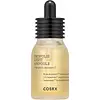What's inside
What's inside
 Key Ingredients
Key Ingredients

 Benefits
Benefits

 Ingredients Side-by-side
Ingredients Side-by-side

Water
Skin ConditioningDipropylene Glycol
HumectantButylene Glycol
HumectantPvp
Emulsion StabilisingGlycerin
HumectantAmmonium Acryloyldimethyltaurate/Vp Copolymer
Polyglyceryl-10 Laurate
Skin ConditioningCaprylyl Glycol
Emollient1,2-Hexanediol
Skin ConditioningGlyceryl Glucoside
HumectantOenothera Biennis Flower Extract
AstringentUlmus Davidiana Root Extract
Skin ConditioningPueraria Lobata Root Extract
HumectantPinus Palustris Leaf Extract
TonicDipotassium Glycyrrhizate
HumectantTocopherol
AntioxidantPortulaca Oleracea Extract
Skin ConditioningCentella Asiatica Extract
CleansingMadecassic Acid
Skin ConditioningAsiatic Acid
Skin ConditioningMadecassoside
AntioxidantAsiaticoside
AntioxidantSodium Hyaluronate
HumectantHydroxypropyltrimonium Hyaluronate
Hydrolyzed Hyaluronic Acid
HumectantSodium Acetylated Hyaluronate
HumectantHyaluronic Acid
HumectantHydrolyzed Sodium Hyaluronate
Skin ConditioningSodium Hyaluronate Crosspolymer
HumectantPotassium Hyaluronate
Skin ConditioningDisodium EDTA
Hydroxyacetophenone
AntioxidantEthylhexylglycerin
Skin ConditioningWater, Dipropylene Glycol, Butylene Glycol, Pvp, Glycerin, Ammonium Acryloyldimethyltaurate/Vp Copolymer, Polyglyceryl-10 Laurate, Caprylyl Glycol, 1,2-Hexanediol, Glyceryl Glucoside, Oenothera Biennis Flower Extract, Ulmus Davidiana Root Extract, Pueraria Lobata Root Extract, Pinus Palustris Leaf Extract, Dipotassium Glycyrrhizate, Tocopherol, Portulaca Oleracea Extract, Centella Asiatica Extract, Madecassic Acid, Asiatic Acid, Madecassoside, Asiaticoside, Sodium Hyaluronate, Hydroxypropyltrimonium Hyaluronate, Hydrolyzed Hyaluronic Acid, Sodium Acetylated Hyaluronate, Hyaluronic Acid, Hydrolyzed Sodium Hyaluronate, Sodium Hyaluronate Crosspolymer, Potassium Hyaluronate, Disodium EDTA, Hydroxyacetophenone, Ethylhexylglycerin
 Reviews
Reviews

Ingredients Explained
These ingredients are found in both products.
Ingredients higher up in an ingredient list are typically present in a larger amount.
1,2-Hexanediol is a synthetic liquid and another multi-functional powerhouse.
It is a:
- Humectant, drawing moisture into the skin
- Emollient, helping to soften skin
- Solvent, dispersing and stabilizing formulas
- Preservative booster, enhancing the antimicrobial activity of other preservatives
Butylene Glycol (or BG) is used within cosmetic products for a few different reasons:
Overall, Butylene Glycol is a safe and well-rounded ingredient that works well with other ingredients.
Though this ingredient works well with most skin types, some people with sensitive skin may experience a reaction such as allergic rashes, closed comedones, or itchiness.
Learn more about Butylene GlycolGlycerin is already naturally found in your skin. It helps moisturize and protect your skin.
A study from 2016 found glycerin to be more effective as a humectant than AHAs and hyaluronic acid.
As a humectant, it helps the skin stay hydrated by pulling moisture to your skin. The low molecular weight of glycerin allows it to pull moisture into the deeper layers of your skin.
Hydrated skin improves your skin barrier; Your skin barrier helps protect against irritants and bacteria.
Glycerin has also been found to have antimicrobial and antiviral properties. Due to these properties, glycerin is often used in wound and burn treatments.
In cosmetics, glycerin is usually derived from plants such as soybean or palm. However, it can also be sourced from animals, such as tallow or animal fat.
This ingredient is organic, colorless, odorless, and non-toxic.
Glycerin is the name for this ingredient in American English. British English uses Glycerol/Glycerine.
Learn more about GlycerinSodium Hyaluronate is hyaluronic acid's salt form. It is commonly derived from the sodium salt of hyaluronic acid.
Like hyaluronic acid, it is great at holding water and acts as a humectant. This makes it a great skin hydrating ingredient.
Sodium Hyaluronate is naturally occurring in our bodies and is mostly found in eye fluid and joints.
These are some other common types of Hyaluronic Acid:
Learn more about Sodium Hyaluronate